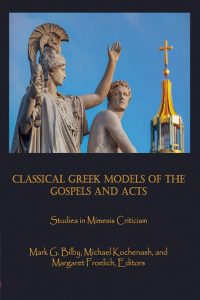Highlighted citations are my additions to footnotes.
4 MacDonald, Dionysian Gospel, 28-29, 30-32. — John 1:1-5, 14, 16, 18 Bacchae 1-4 ….
5 MacDonald, Dionysian Gospel, 29. — John 1:6-8 Bacchae 10-12
6 MacDonald, Dionysian Gospel, 29-30. — John 1:9-12 Bacchae 26-30
7 MacDonald, Dionysian Gospel, 38-40. — John 1:19-51 …..
8 MacDonald, Dionysian Gospel, 40-44, 67. — John 2:1-11, 20:30-31 Bacchae 142, 704-7, 712-13
9 MacDonald, Dionysian Gospel, 46-49. — John 5:2-9 Bacchae 180-98, 204-09
10 MacDonald, Dionysian Gospel, 48-49. — John 3.1-24 Bacchae 187-89, 193
11 MacDonald, Dionysian Gospel, 51-55. — John 4:1-42 Bacchae 704-5; 216-223
12 MacDonald, Dionysian Gospel, 64-67. — John 6:53-66 Bacchae 139, 735, 739, 1133-36
13 MacDonald, Dionysian Gospel, 68-71, 89-95. — John 8:12-19; 18:28-19:16 Bacchae 460-506
14 MacDonald, Dionysian Gospel, 71-73. — John 8:32-37, 58-59 Bacchae 498, 641, 432-518
15 MacDonald, Dionysian Gospel, 73-75. — John 9:1-41 Bacchae 319…
16 MacDonald, Dionysian Gospel, 75-76. — John 10:39-42 Bacchae 636-37
17 MacDonald, Dionysian Gospel, 79-81. — John 11:6-44 Bacchae 498, contra 1374-76
18 MacDonald, Dionysian Gospel, 81-82. — John 11:45-50, 53-57 Bacchae 677-774, 778-80, 784-85, 352-56
19 MacDonald, Dionysian Gospel, 82-83. — John 12:12-15, 17-19 Bacchae 216-20
20 MacDonald, Dionysian Gospel, 83-85. — John 13:1, 31-35; 14:4, 6, 31; 15:1-2, 4 ….
21 MacDonald, Dionysian Gospel, 85-87. — John 18:1-13 Bacchae 434-46
22 MacDonald, Dionysian Gospel, 96-100. — John 19:17-30 Bacchae 1115-21
23 MacDonald, Dionysian Gospel, 102-08. — John 20:1, 11-18 Bacchae 1212, 1298…
24 MacDonald, Dionysian Gospel, 108-09. — John 20:19, 21-23 Bacchae 1340-41, 1354-56; John 20:30-31 Bacchae 1388-92
25 MacDonald, Dionysian Gospel, 79.
26 MacDonald, Dionysian Gospel, 102-08
Numerous and dense parallels rise to the level of highly probable to certain indications of dependence on the Bacchae of Euripides. Such dependence can be seen in a wide range of ways, from identical and unique word choice, to themes and dramatic settings, to character developments and plot twists.
• Like Dionysus, Jesus is a god who comes to earth in mortal disguise.4
• He has a champion heralding him.5
• The people’s leaders reject him.6
• His symbolic names abound.7
• Jesus’s first, stage-setting miracle is clearly a Dionysian one; both bring forth wine miraculously.8
• Yet that is only one of numerous, identity-establishing miracles that the two share in common. Jesus and Dionysus both make old men move as if they are young again.9
• Both prompt devotion from old men in spite of competing family loyalties.10
• The Johannine Jesus provides his own miraculous supply of water and attracts women followers known for their promiscuity, just as Dionysus was famed to do.11
• Both vex their initiates/disciples with the requirement of eating the god’s raw flesh and drinking his blood.12
• Iesus Dionysos is harshly interrogated as to his provenance and paternity.13
• He is the liberator of slaves.14
• He is the one whom his opponents cannot see but the formerly blind clearly can.15
• He is the one who can miraculously escape arrest.16
• He is the one whose initiates travel safely into the underworld and are brought back to life.17
• Jesus and Dionysus are similarly opposed by god-fighters.18
• Yet both are equally acclaimed by many groups of people.19
• Jesus imitates Dionysus even as he rivals him as the true grapevine.20
• Both willingly meet their own arrest.21
• Though the ignominy of the crucifixion and lack of vengeance are uncharacteristic of Dionysus, the Johannine Jesus still plays a Bacchae-inspired role in his imitation of Pentheus, the murdered king.22
• The Johannine resurrection interweaves characteristics of Dionysus and Pentheus in its depiction of the defiled, royal corpse being raised within a garden and women followers who surround him but also do not initially recognize his body.23
• The disembodied apotheosis of the first edition of John is hallmark Dionysus.24
Other adduced parallels run the gamut from uncertain to puzzling. In these occasions, it may simply be that MacDonald knows these texts far better than readers like I do and that he sees connections that have to be explained point by point to the uninitiated. For example, Mary’s anointing of the feet of Jesus is adduced as John’s depiction of Jesus as “a different kind of lover from Dionysus.”25 Yes, Jesus is a murdered king like Pentheus, but why is it that Mary Magdalene rather than Mary the Mother plays the part of the mother of Pentheus, who cannot recognize her son’s body?26 Caveats notwithstanding, these minor quibbles and questions do not impair MacDonald’s Dionysian argument in the least.
(Bilby, 49-51. Formatting is mine)
Bilby, Mark G. 2018. “The First Dionysian Gospel: Imitational and Redactional Layers in Luke and John.” In Classical Greek Models of the Gospels and Acts: Studies in Mimesis Criticism, edited by Mark G. Bilby, Michael Kochenash, and Margaret Froelich, 49–68. Claremont, Calif: Claremont Press.

